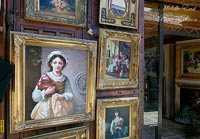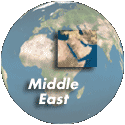© 2005 William Matar, All Rights Reserved.
In this way it presents all the stages of the evolution of civilisation up to our own time. One sees the first settlement in the form of a primitive village with its huts of fisherfolk or hunters, then sedentary life and the construction of urban quarters, then commercial expansion and maritime relations with all the various countries of the Eastern Mediterranean Basin, particularly with Egypt, then the state of vassal to the Mesopotamian, Greek, Roman and Arab empires.
It was at Byblos that the western consonantal alphabet was invented and that the art of making books was developed, starting with the treatment of the Egyptian papyrus plant. >From the name of Byblos we have derivations such as Bible, bibliography, bibliophile and the French bibliothèque. The first clear evidence of writing with an alphabet comes from the tomb of King Ahiram of Byblos, dating from the 13th century before Christ.
Its engineers and artisans were called on to construct the temple of Jerusalem under Solomon in 950 B.C.. Its religious cults and their temples dedicated to the god Baal (Lord of Earth and Sky) and of his partner the Lady of Byblos (Ishtar, goddess of fertililty) were famous throughout the Eastern Mediterranean, as the famous traveller Lucian of Samosata tells us, writing in the 2nd century A.D..
One can still admire where it stands the fortress of the Franks, built by the Genoese in 1108, the wall surrounding the area 300-metre by 200 m. of the medieval town, the Romanesque church of St. John built in 1115, the 5th century Byzantine church overlooking the harbour, the small port itself whose entrance is crowned by a small fort, the remains of the formidable Phoenician rampart with its sloping bank from the 3rd millennium B.C., the ruins of a Roman amphitheatre turned towards the sea, the impressive hypogea and saccophagi of the kings of the 2nd millennium B.C., and the colonnades along the Roman ways. To all these may be added the remarkable museum of fossil fish from the region anything from 100 to 200 million years old. Truly, Jbeil-Byblos, provincial seat of the Qa'em makam, merits the attention of the historians, researchers, tourists and pleasure-seekers that it constantly attracts.
The 2nd Edition of the Middle East Peace - World Wide Panorama is a cooperative effort by VR photographers living in United Arab Emirates (UAE), Lebanon, Israel, and Egypt. We have organized, worked together and produced QTVRs that are linked together. Our message is clear, we cannot ignore each other any more since we all benefit from peace. This is our way to contribute to the Middle East peace efforts.
The members of this family are (in alphabetical order): Andy Alpern (Israel) Eldar Sharir (Israel), Fadi Saikali (Lebanon), Loyd Almeda (Dubai), Rana Mahmood (Dubai), Samir Ahmed (Dubai), Waleed Nassar (Egypt), William Matar (Lebanon) and Yaniv Sirton (Israel). Thanks go to all participants for contributing to this effort, to Samir Ahmed for designing and writing the flash in our QTVR's, and to Waleed Nassar for coming up with the idea of this edition.



 Tap or click the zoom icon in the bottom right corner of the picture to switch between in-page and fullscreen view
Tap or click the zoom icon in the bottom right corner of the picture to switch between in-page and fullscreen view